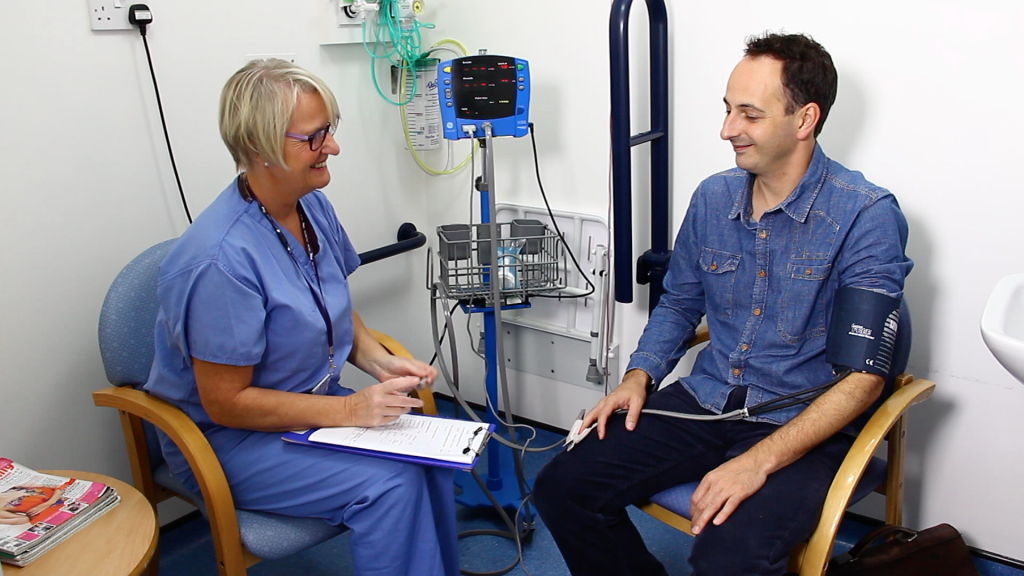The Patient Information Forum (PIF) has just released a report on the ‘Perfect Patient Information Journey’.
It identifies seven-steps that all organisations should take to provide people with long-term conditions with the information they need to self-manage, make decisions and understand their condition.
Here we’ll explore how Health & Care Videos provides the ‘Perfect Patient Information Journey’ and how we might help Trusts and CCGs improve care for patients with long-term conditions.
How do videos fit into the ‘Perfect Patient Information Journey’?
We believe that our videos and video libraries can play a big part in creating the ‘Perfect Patient Information Journey’.
This is because videos can explain complex/daunting procedures in a simple, accessible and familiar way. They’re engaging and easy for patients to revisit.
Here we’ll go through the seven steps outlined by PIF, and see how video can play a part in the ‘Perfect Patient Information Journey’.
1. Get the leadership team on board and clarify roles
At Health & Care Videos, we work closely with leadership teams in GP practices, CCGs, Trusts and other health and care organisations.
During the early stages of a project, we outline the value of patient information videos by showing examples of these videos in action.
We also identify the roles within the team so we know who the decision makers are and who will need support in certain areas. We determine who will:
- Lead the project
- Distribute resources (i.e share the videos)
- Sign off the content
- Embed video into the healthcare pathways
Our team can assist all members of the team and tailor solutions specifically for each client. This stage makes it much easier to complete the project and ensures that our videos reach their maximum potential for every client.
2. Find out what your patients think
We know from experience that patients respond well to video. After all, it’s an engaging, familiar and memorable media.
Our libraries have been created with patients in mind, and we now have a comprehensive range of patient-facing videos in several styles, including:
- Show & tell/How to guides
- Animations
- Interviews
- Promotional videos
- Acted scenarios
In some cases, patients have actually advised us on which videos to create and include in our libraries. Asking for this feedback helps identify gaps in patient information, and consequently creates a useful resource they can use in the future.
We often conduct surveys at the beginning of projects to identify key areas for improvement. This has helped us create several standard sector libraries that offer a very comprehensive overview of most conditions.
3. Find out what your staff think
We have found that it’s very important to get feedback from staff before you start implementing videos into the care pathway.
Without the staff, you cannot guarantee that the videos will reach the patients. At this stage we demonstrate the effectiveness of our videos and ask for suggestions on topics to use.
In some cases, staff can even be involved in video production either being filmed performing procedures or interviewed about a project or their role. This helps them feel involved and get behind the initiative.
4. Map the current patient information journey and identify gaps
Using the insights from patients, staff and our experience, we create a map of the patient pathway and highlight areas where video or other interventions might be appropriate.
Previously, we have created a series of apps to assist with long-term condition management. This includes:
- Rheumatology Connect
- Weight Management Torbay
- Diabetes Bristol
We then outline this plan to the leadership team and agree on a plan of action. We then assign actions (to both the client and our own team) and begin creating the content
5. Make improvements
At this stage, we create the videos (or library) and start placing them at appropriate points in the healthcare pathway.
These points vary due to organisation, target audience and several other factors, but often include:
- Organisation’s website
- Appointment letters
- Social media
- Prescription during appointment
6. Evaluate the impact of changes made
Evaluation is vital to determining success and optimising your approach, so it is a major part of our strategy and we encourage our clients to conduct their own evaluations.
Initially we assess the impact we have through video analytics. Then we talk to patients and staff about the effect they’ve seen and there’s an option in some libraries for patients to leave feedback. In some cases, we even run surveys to determine how effective our interventions have been.
Sometimes there is also quantifiable data we can look at. For example, changes in appointment numbers, missed appointments, follow-ups etc can all be attributed to the use of video.
However, it’s important to remember that there may be other factors contributing to this change. Some other extraneous factor may have had an impact that the data does not account for.
7. Benchmark annually and maintain patient involvement
Our team evaluates our projects consistently until the contract comes to an end. We also review all of our videos three years after they were created to ensure that the information is still accurate.
We maintain patient involvement by inviting both patients and staff to offer suggestions for new subjects as well as expanding on current solutions.
For example, we held a focus group to help us determine key points for our app, Rheumatology Connect. The group said that the app would re-engage them in their care and actually being involved in the focus group helped them take a more active role too.
In conclusion, we feel that Health & Care Videos does help create a ‘Perfect Patient Information Journey’. It hits all seven of PIF’s points with a simple and effective intervention.
We utilise a familiar medium in an effective way, which vastly improves the patient experience.
If you want to discover how to use video to create a perfect patient information journey, get in touch with our team today.

